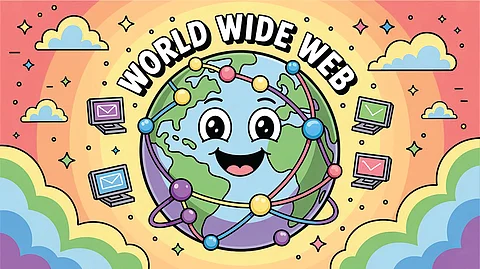

ISTOCK
Imagine waking up in a world where you couldn’t message your friends, watch puppy videos, look up homework help, or play games with someone living across the globe. Hard to picture, right? Yet, only a few decades ago, none of this was possible—there were no memes, no viral dances, no endless scrolling. All of these wonders exist thanks to something we use every day but rarely stop to think about: the World Wide Web.
Let’s rewind to the late 1980s. Computers did exist, but they were like islands in the middle of a huge ocean. You could use one computer to create documents or play simple games, but it was tough to connect with anyone outside your own home or school. If you wanted to send a message, you might use something called “email” if you were very lucky—or you just wrote a letter! Then, in 1989, a scientist named Tim Berners-Lee, working at a place called CERN in Switzerland, came up with a brilliant idea. What if we could link information on different computers, using a network that anyone, anywhere, could access? His idea was the start of the World Wide Web.
At first, only a handful of scientists and researchers used the Web, sharing information about their experiments. The first website was nothing flashy—it mostly had text and links to other pages, like a super-basic online noticeboard. But this idea—of clicking from one page to another, from one website to the next—changed everything. Soon, the Web began to spread. More and more people started building websites, and before long, anyone with a computer (and a very loud, slow modem) could surf the Web from home.
You might wonder what makes the Web so different from the “internet.” Here’s a secret: the internet is the giant network that connects millions of computers around the world, like invisible wires running under oceans and across countries. The World Wide Web is just one way to use the internet, like a magical library that lets you hop from one book to another just by clicking your mouse. Thanks to the Web, you can send messages, upload videos, do research, and watch funny cats—all by following hyperlinks.
In the early days, web pages looked quite plain, with simple colours and blocky text. There were no likes, no comments, and definitely no emojis. People would use something called “dial-up,” which made a weird screeching noise every time you connected. It could take five minutes just to load a single picture! Even so, it was astonishing. For the first time, you could discover new ideas, read the news from faraway countries, or join a chatroom to meet people with the same hobbies—even if you lived on opposite sides of the planet.
As more people came online, the Web became an exciting, bustling place. New inventions kept popping up—search engines like Google helped you find anything in seconds. Social media sites let you share photos and videos with friends. Online games meant you could battle, build, or team up with people you’d never met in real life. The Web wasn’t just about finding information anymore; it became a space for sharing, creating, and having fun.
Of course, it’s not all fun and games. Just like in the real world, the Web has its tricky spots—spam, fake news, cyberbullies, and scams. That’s why it’s important to use your “digital common sense,” the way you look both ways before crossing a road. Stick to safe sites, never share private information, and always ask a trusted adult if something seems weird or makes you uncomfortable. There’s loads of good out there, but a little caution keeps the Web a safe place to explore.
One of the most amazing things about the Web is that it belongs to everyone. Unlike a theme park or private club, you don’t have to buy a ticket or get special permission to join. Anyone, anywhere in the world, can build a website, share their story, or start a movement. People use the Web to learn languages, raise money for good causes, or even organise protests and change the world. During the Covid-19 pandemic, it was the Web that kept schools, families, and friends connected—even when everyone was stuck at home.
If you’re curious about how the Web works, you’re not alone. Many teens today are learning to code websites and apps, becoming digital creators, not just users. The programming languages that power the Web—like HTML, CSS, and JavaScript—are like the building blocks of your favourite games and websites. If you can dream it, there’s a good chance you can build it, too!
Before “World Wide Web” caught on, Berners-Lee called his invention “Mesh.” Would you rather surf the Mesh?
In the early days, the Web loaded images line by line. Some pictures took longer to appear than it takes to eat your lunch!
ISTOCK
Today, there are more than 1.1 billion websites online, but most are never visited. Some are just made for testing or practice.
Scientists at Cambridge University set up the first webcam—not for security, but to see if the coffee pot was full from their desks!
The first popular browser was called Mosaic, and others included Netscape Navigator and Internet Explorer. Now we have Chrome, Firefox, Edge, and more.
Websites used to be plain and simple, but now you can stream music, play games, and even talk to AI—all on the Web.
You don’t need to be a grown-up or a tech wizard. With a little curiosity, you can make your own website and share your ideas with the world!